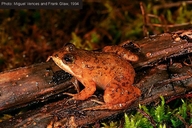|
Description
M 24-26 mm, F 26-31 mm. Tibiotarsal articulation reaches the eye, sometimes the nostril. Hand without webbing, foot webbing 1(1), 2i(1), 2e(1), 3i(2), 3e(1.5), 4i/e(2), 5(1). Dorsal skin slightly to moderately granular, usually with dorsolateral folds. Colouration dorsally variable, often light brown with darker markings, with or without vertebral stripe. Males with a weakly distensible single subgular vocal sac and distinct, relatively large femoral glands (Glaw and Vences 2007). Distribution and Habitat
Country distribution from AmphibiaWeb's database: Madagascar
Species is located in Ambatolampy, Ambohitantely, Andrangoloaka, Antananarivo, Antoetra, Antratrabe, Beanjombona, Ibity, Manjakatompo, Manjavona valley, Mantasoa, Nosiarivo, Ranomafanakely (Glaw and Vences 2007).
It is widely distributed in east-central Madagascar at 1000-2000m asl, from Ambohitantely south to south of Ranomafana (Vences and Vallan 2008). Life History, Abundance, Activity, and Special Behaviors
Habits: A common species in Madagascar’s highlands and the only mantelline species that can even be found in Antananarivo, where it populates for example the Tsimbazaza garden. A secretive small species that can be seen jumping along small streams and that often calls during the day from very hidden positions in the deep grass along such streams; sometimes calls are also emitted at night from more exposed positions (Glaw and Vences 2007).
Calls: A series of 5-14 pulsed notes (Glaw and Vences 2007).
Trends and Threats
This species is listed as least concern in view of its wide distribution, tolerance of a broad range of habitats, presumed large population, and because it is unlikely to be declining fast enough to qualify for listing in a more threatened category. Its population is stable and it lives near seeps and tiny amounts of slow-flowing water in open areas, rice paddies and other agricultural areas, forest edge, and inside montane forest. It has been found in gardens in Antananarivo. The egg deposition side is unknown, but the tadpoles have been found in seeps. It is probably not affected by deforestation, and is adaptable and is unlikely to be threatened (Vences and Vallan 2008). Comments
Taken with permission from Glaw and Vences (2007) and Vences and Vallan (2008).
References
Glaw, F., and Vences, M. (2007). Field Guide to the Amphibians and Reptiles of Madagascar. Third Edition. Vences and Glaw Verlag, Köln.
Vences, M. and Vallan, D. (2008). Mantidactylus alutus. In: IUCN 2008. 2008 IUCN Red List of Threatened Species. www.iucnredlist.org. Downloaded on 31 March 2009.
Originally submitted by: Miguel Vences and Frank Glaw (first posted 2000-11-21)
Edited by: Catherine Aguilar (2009-05-01)Species Account Citation: AmphibiaWeb 2009 Mantidactylus alutus <https://amphibiaweb.org/species/4576> University of California, Berkeley, CA, USA. Accessed Jun 5, 2025.
Feedback or comments about this page.
Citation: AmphibiaWeb. 2025. <https://amphibiaweb.org> University of California, Berkeley, CA, USA. Accessed 5 Jun 2025.
AmphibiaWeb's policy on data use.
|
